University Essay: Management Accounting through BSC Technique Analysis
VerifiedAdded on 2023/01/18
|14
|3433
|38
Essay
AI Summary
This essay examines the Balanced Scorecard (BSC) technique as a tool for strategic management accounting, focusing on its role in evaluating and communicating organizational strategies. It explores the four dimensions of the BSC: customer, financial, learning and growth, and internal business processes, highlighting how these segments contribute to performance measurement and strategy formulation. The essay provides a detailed analysis of the BSC system, including its effectiveness and the advantages and disadvantages of its implementation. A case study of Tesco is included to illustrate the practical application of the BSC and its impact on the company's strategic objectives. The essay also discusses the importance of communication within the organization and how the BSC facilitates this process across different departments. The study emphasizes the BSC's evolution from a performance analysis tool to a strategic development method that enhances overall organizational efficiency and goal achievement.
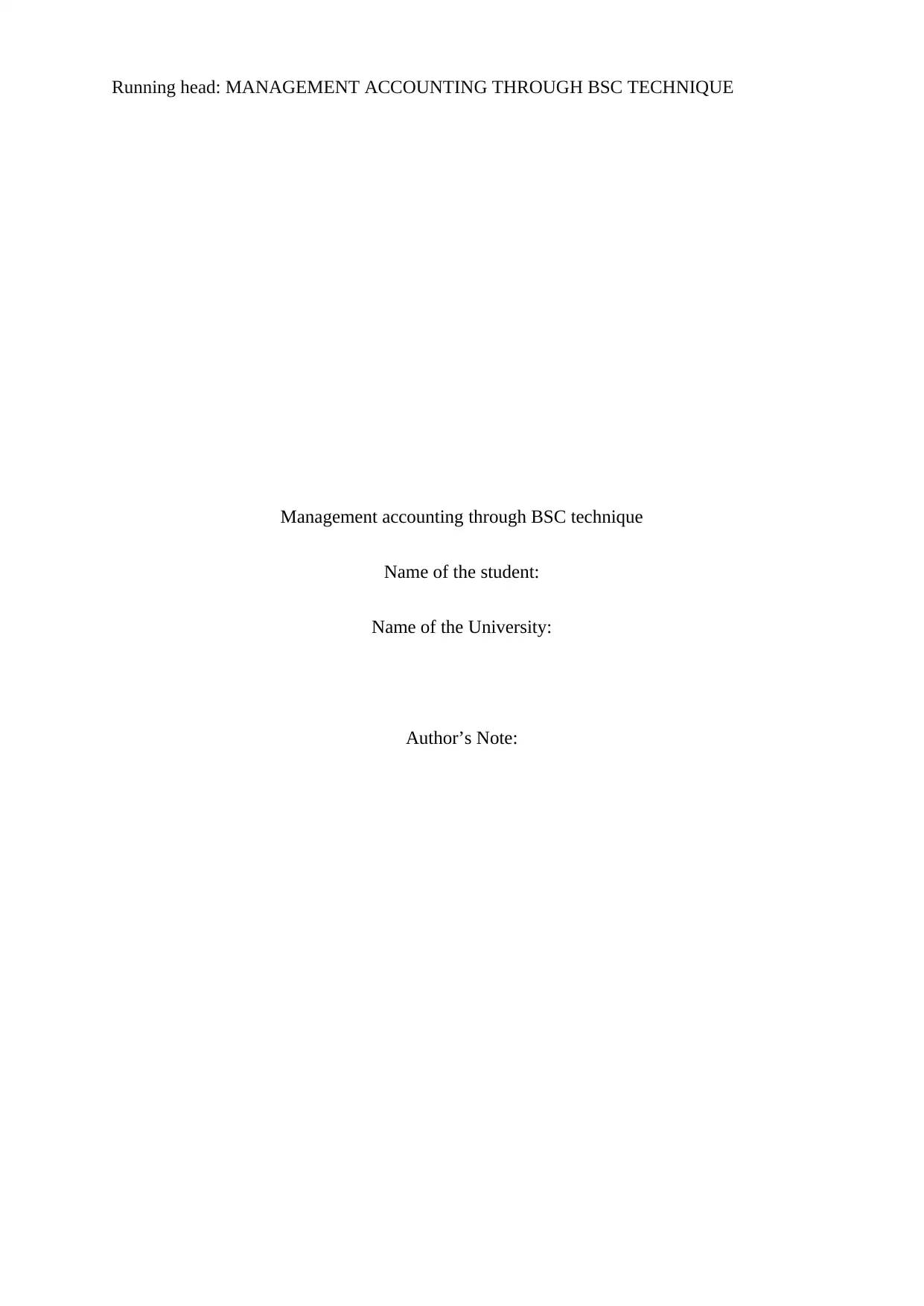
Running head: MANAGEMENT ACCOUNTING THROUGH BSC TECHNIQUE
Management accounting through BSC technique
Name of the student:
Name of the University:
Author’s Note:
Management accounting through BSC technique
Name of the student:
Name of the University:
Author’s Note:
Paraphrase This Document
Need a fresh take? Get an instant paraphrase of this document with our AI Paraphraser
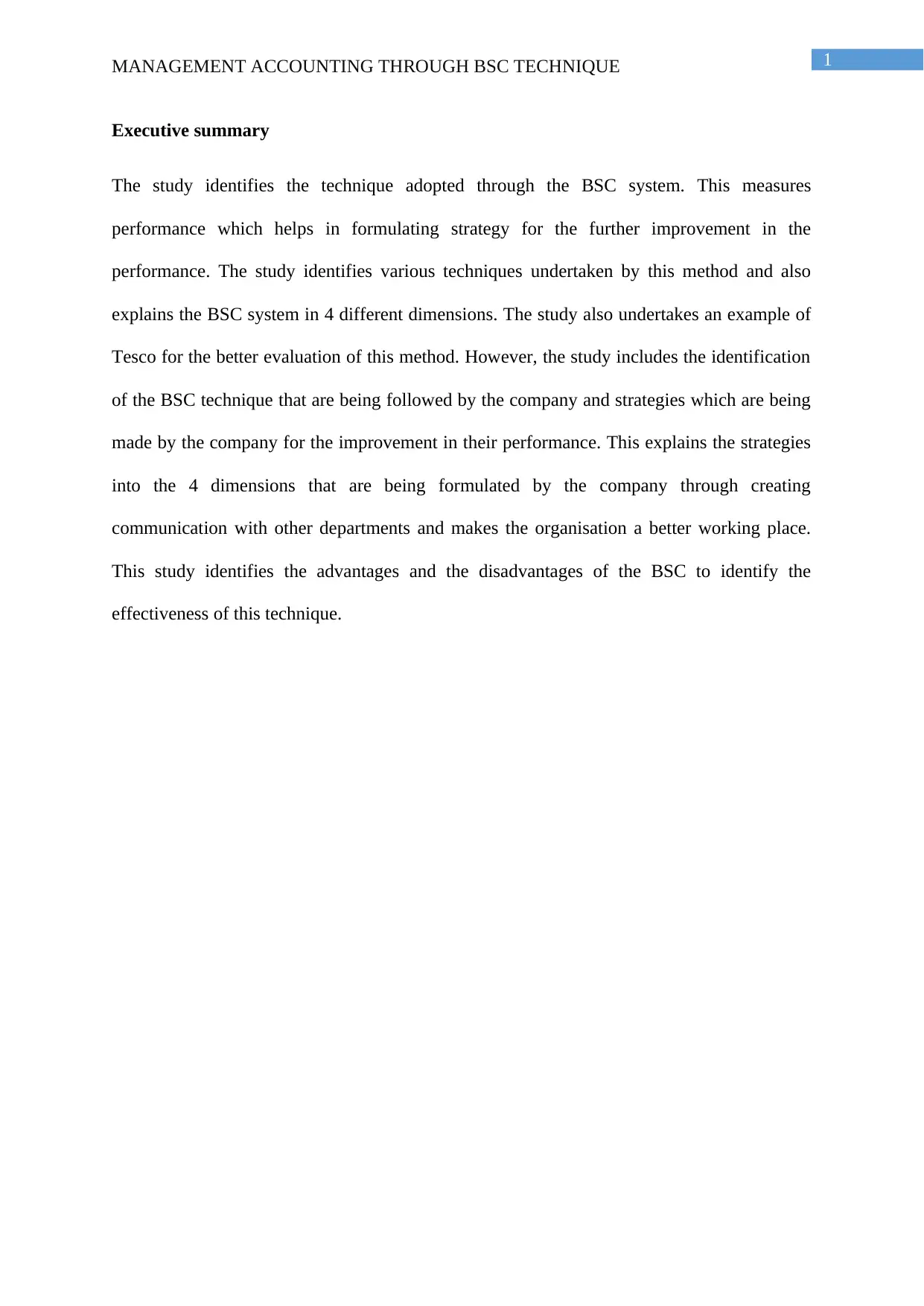
1MANAGEMENT ACCOUNTING THROUGH BSC TECHNIQUE
Executive summary
The study identifies the technique adopted through the BSC system. This measures
performance which helps in formulating strategy for the further improvement in the
performance. The study identifies various techniques undertaken by this method and also
explains the BSC system in 4 different dimensions. The study also undertakes an example of
Tesco for the better evaluation of this method. However, the study includes the identification
of the BSC technique that are being followed by the company and strategies which are being
made by the company for the improvement in their performance. This explains the strategies
into the 4 dimensions that are being formulated by the company through creating
communication with other departments and makes the organisation a better working place.
This study identifies the advantages and the disadvantages of the BSC to identify the
effectiveness of this technique.
Executive summary
The study identifies the technique adopted through the BSC system. This measures
performance which helps in formulating strategy for the further improvement in the
performance. The study identifies various techniques undertaken by this method and also
explains the BSC system in 4 different dimensions. The study also undertakes an example of
Tesco for the better evaluation of this method. However, the study includes the identification
of the BSC technique that are being followed by the company and strategies which are being
made by the company for the improvement in their performance. This explains the strategies
into the 4 dimensions that are being formulated by the company through creating
communication with other departments and makes the organisation a better working place.
This study identifies the advantages and the disadvantages of the BSC to identify the
effectiveness of this technique.
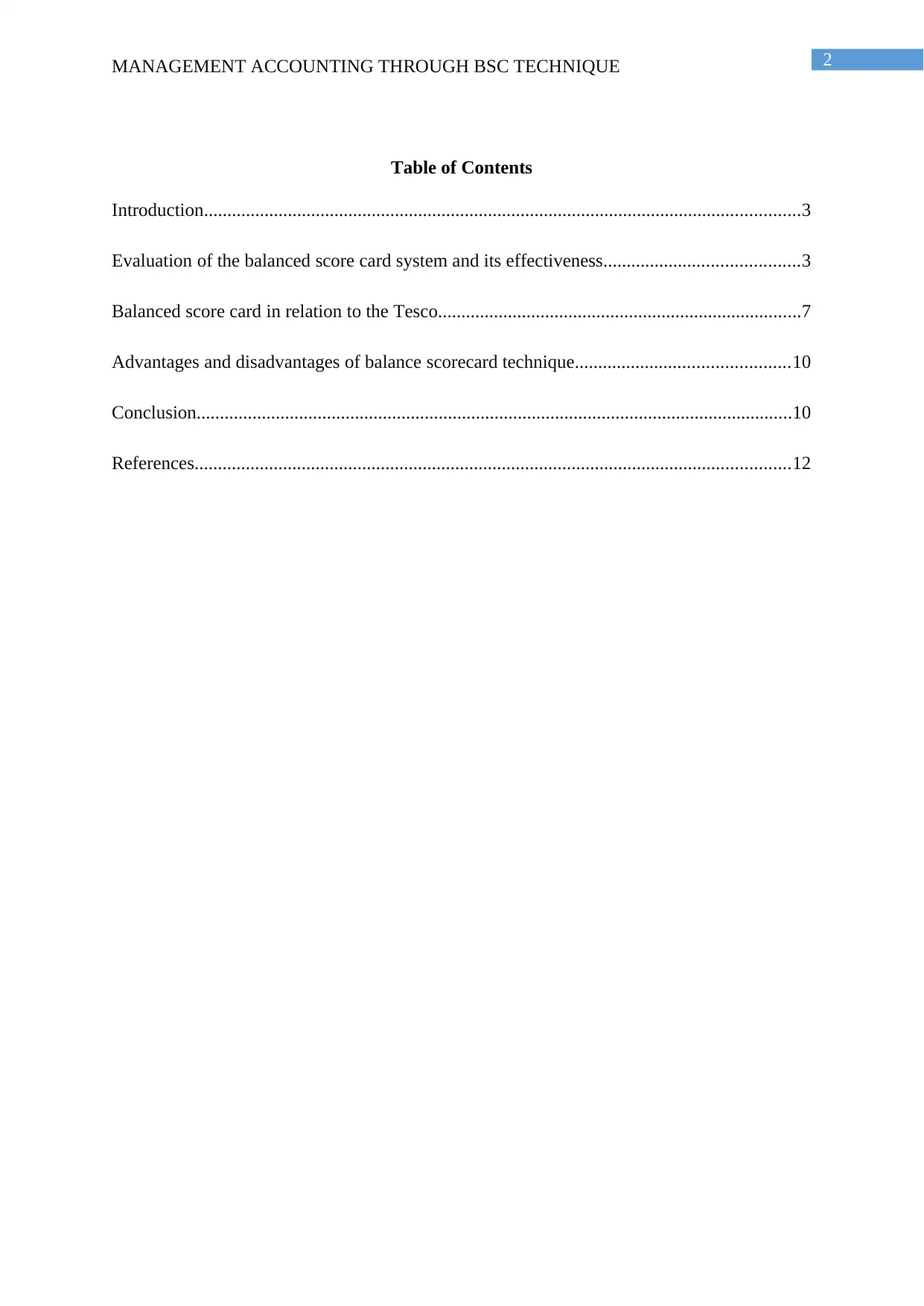
2MANAGEMENT ACCOUNTING THROUGH BSC TECHNIQUE
Table of Contents
Introduction................................................................................................................................3
Evaluation of the balanced score card system and its effectiveness..........................................3
Balanced score card in relation to the Tesco..............................................................................7
Advantages and disadvantages of balance scorecard technique..............................................10
Conclusion................................................................................................................................10
References................................................................................................................................12
Table of Contents
Introduction................................................................................................................................3
Evaluation of the balanced score card system and its effectiveness..........................................3
Balanced score card in relation to the Tesco..............................................................................7
Advantages and disadvantages of balance scorecard technique..............................................10
Conclusion................................................................................................................................10
References................................................................................................................................12
⊘ This is a preview!⊘
Do you want full access?
Subscribe today to unlock all pages.

Trusted by 1+ million students worldwide
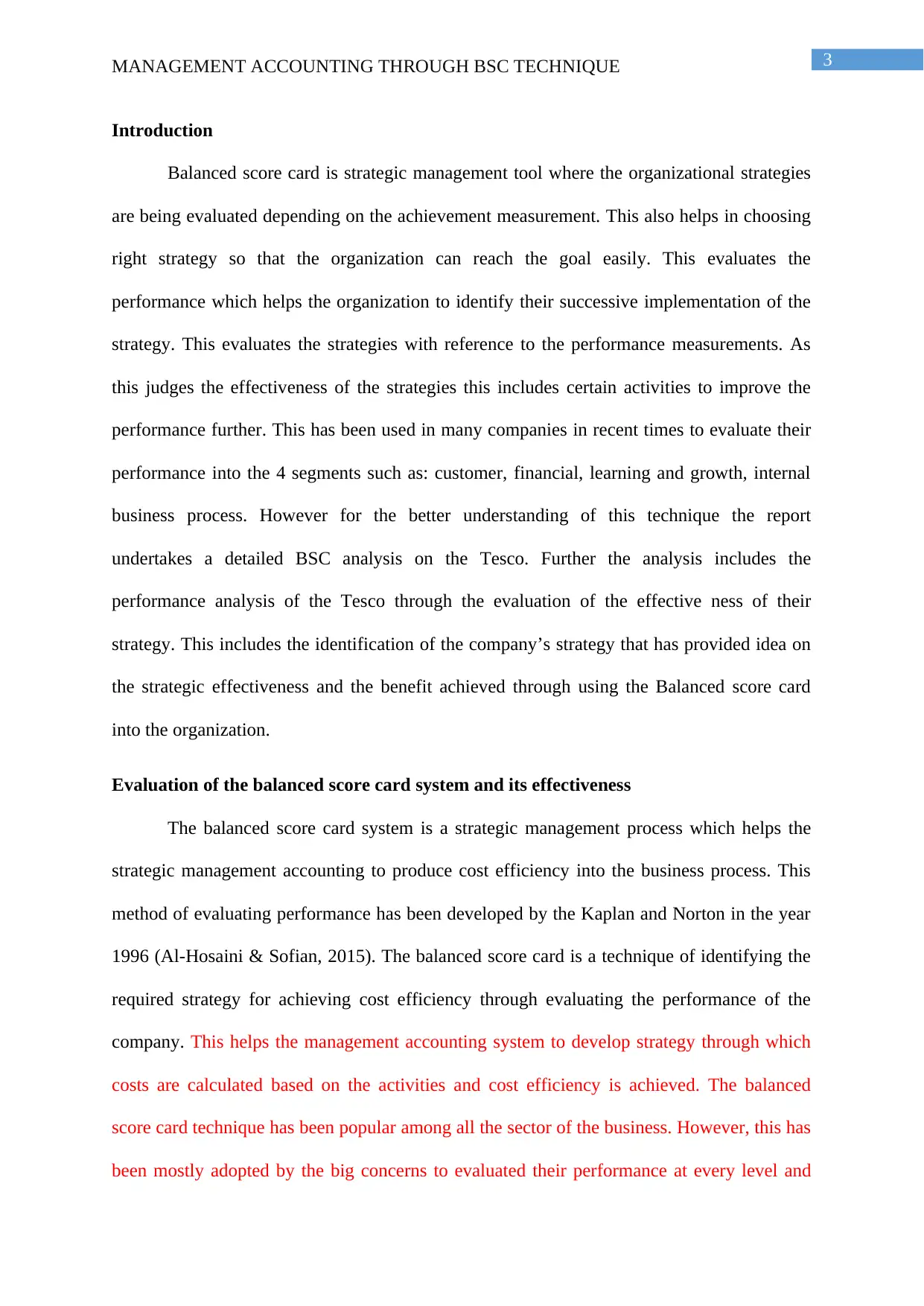
3MANAGEMENT ACCOUNTING THROUGH BSC TECHNIQUE
Introduction
Balanced score card is strategic management tool where the organizational strategies
are being evaluated depending on the achievement measurement. This also helps in choosing
right strategy so that the organization can reach the goal easily. This evaluates the
performance which helps the organization to identify their successive implementation of the
strategy. This evaluates the strategies with reference to the performance measurements. As
this judges the effectiveness of the strategies this includes certain activities to improve the
performance further. This has been used in many companies in recent times to evaluate their
performance into the 4 segments such as: customer, financial, learning and growth, internal
business process. However for the better understanding of this technique the report
undertakes a detailed BSC analysis on the Tesco. Further the analysis includes the
performance analysis of the Tesco through the evaluation of the effective ness of their
strategy. This includes the identification of the company’s strategy that has provided idea on
the strategic effectiveness and the benefit achieved through using the Balanced score card
into the organization.
Evaluation of the balanced score card system and its effectiveness
The balanced score card system is a strategic management process which helps the
strategic management accounting to produce cost efficiency into the business process. This
method of evaluating performance has been developed by the Kaplan and Norton in the year
1996 (Al-Hosaini & Sofian, 2015). The balanced score card is a technique of identifying the
required strategy for achieving cost efficiency through evaluating the performance of the
company. This helps the management accounting system to develop strategy through which
costs are calculated based on the activities and cost efficiency is achieved. The balanced
score card technique has been popular among all the sector of the business. However, this has
been mostly adopted by the big concerns to evaluated their performance at every level and
Introduction
Balanced score card is strategic management tool where the organizational strategies
are being evaluated depending on the achievement measurement. This also helps in choosing
right strategy so that the organization can reach the goal easily. This evaluates the
performance which helps the organization to identify their successive implementation of the
strategy. This evaluates the strategies with reference to the performance measurements. As
this judges the effectiveness of the strategies this includes certain activities to improve the
performance further. This has been used in many companies in recent times to evaluate their
performance into the 4 segments such as: customer, financial, learning and growth, internal
business process. However for the better understanding of this technique the report
undertakes a detailed BSC analysis on the Tesco. Further the analysis includes the
performance analysis of the Tesco through the evaluation of the effective ness of their
strategy. This includes the identification of the company’s strategy that has provided idea on
the strategic effectiveness and the benefit achieved through using the Balanced score card
into the organization.
Evaluation of the balanced score card system and its effectiveness
The balanced score card system is a strategic management process which helps the
strategic management accounting to produce cost efficiency into the business process. This
method of evaluating performance has been developed by the Kaplan and Norton in the year
1996 (Al-Hosaini & Sofian, 2015). The balanced score card is a technique of identifying the
required strategy for achieving cost efficiency through evaluating the performance of the
company. This helps the management accounting system to develop strategy through which
costs are calculated based on the activities and cost efficiency is achieved. The balanced
score card technique has been popular among all the sector of the business. However, this has
been mostly adopted by the big concerns to evaluated their performance at every level and
Paraphrase This Document
Need a fresh take? Get an instant paraphrase of this document with our AI Paraphraser
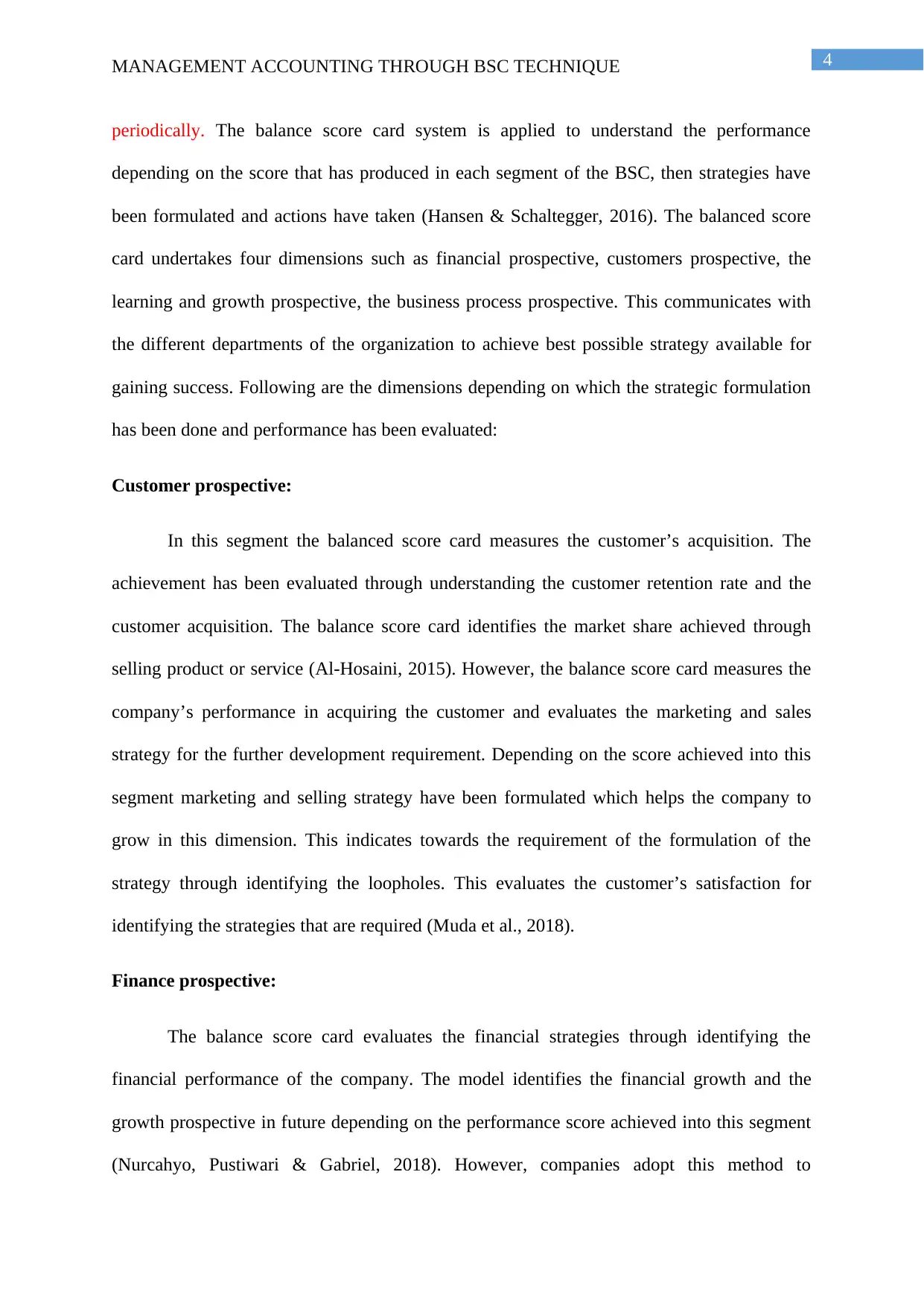
4MANAGEMENT ACCOUNTING THROUGH BSC TECHNIQUE
periodically. The balance score card system is applied to understand the performance
depending on the score that has produced in each segment of the BSC, then strategies have
been formulated and actions have taken (Hansen & Schaltegger, 2016). The balanced score
card undertakes four dimensions such as financial prospective, customers prospective, the
learning and growth prospective, the business process prospective. This communicates with
the different departments of the organization to achieve best possible strategy available for
gaining success. Following are the dimensions depending on which the strategic formulation
has been done and performance has been evaluated:
Customer prospective:
In this segment the balanced score card measures the customer’s acquisition. The
achievement has been evaluated through understanding the customer retention rate and the
customer acquisition. The balance score card identifies the market share achieved through
selling product or service (Al-Hosaini, 2015). However, the balance score card measures the
company’s performance in acquiring the customer and evaluates the marketing and sales
strategy for the further development requirement. Depending on the score achieved into this
segment marketing and selling strategy have been formulated which helps the company to
grow in this dimension. This indicates towards the requirement of the formulation of the
strategy through identifying the loopholes. This evaluates the customer’s satisfaction for
identifying the strategies that are required (Muda et al., 2018).
Finance prospective:
The balance score card evaluates the financial strategies through identifying the
financial performance of the company. The model identifies the financial growth and the
growth prospective in future depending on the performance score achieved into this segment
(Nurcahyo, Pustiwari & Gabriel, 2018). However, companies adopt this method to
periodically. The balance score card system is applied to understand the performance
depending on the score that has produced in each segment of the BSC, then strategies have
been formulated and actions have taken (Hansen & Schaltegger, 2016). The balanced score
card undertakes four dimensions such as financial prospective, customers prospective, the
learning and growth prospective, the business process prospective. This communicates with
the different departments of the organization to achieve best possible strategy available for
gaining success. Following are the dimensions depending on which the strategic formulation
has been done and performance has been evaluated:
Customer prospective:
In this segment the balanced score card measures the customer’s acquisition. The
achievement has been evaluated through understanding the customer retention rate and the
customer acquisition. The balance score card identifies the market share achieved through
selling product or service (Al-Hosaini, 2015). However, the balance score card measures the
company’s performance in acquiring the customer and evaluates the marketing and sales
strategy for the further development requirement. Depending on the score achieved into this
segment marketing and selling strategy have been formulated which helps the company to
grow in this dimension. This indicates towards the requirement of the formulation of the
strategy through identifying the loopholes. This evaluates the customer’s satisfaction for
identifying the strategies that are required (Muda et al., 2018).
Finance prospective:
The balance score card evaluates the financial strategies through identifying the
financial performance of the company. The model identifies the financial growth and the
growth prospective in future depending on the performance score achieved into this segment
(Nurcahyo, Pustiwari & Gabriel, 2018). However, companies adopt this method to
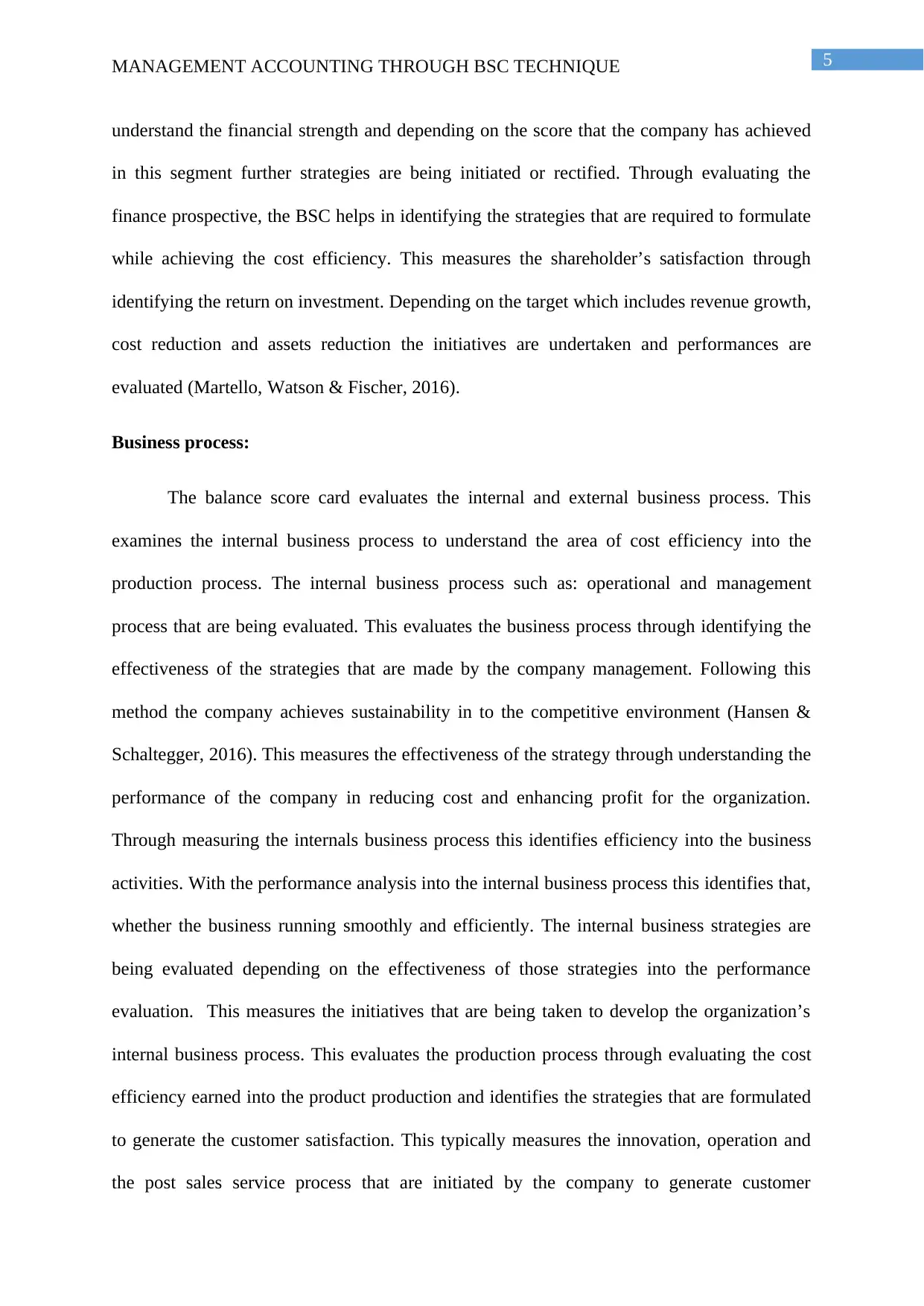
5MANAGEMENT ACCOUNTING THROUGH BSC TECHNIQUE
understand the financial strength and depending on the score that the company has achieved
in this segment further strategies are being initiated or rectified. Through evaluating the
finance prospective, the BSC helps in identifying the strategies that are required to formulate
while achieving the cost efficiency. This measures the shareholder’s satisfaction through
identifying the return on investment. Depending on the target which includes revenue growth,
cost reduction and assets reduction the initiatives are undertaken and performances are
evaluated (Martello, Watson & Fischer, 2016).
Business process:
The balance score card evaluates the internal and external business process. This
examines the internal business process to understand the area of cost efficiency into the
production process. The internal business process such as: operational and management
process that are being evaluated. This evaluates the business process through identifying the
effectiveness of the strategies that are made by the company management. Following this
method the company achieves sustainability in to the competitive environment (Hansen &
Schaltegger, 2016). This measures the effectiveness of the strategy through understanding the
performance of the company in reducing cost and enhancing profit for the organization.
Through measuring the internals business process this identifies efficiency into the business
activities. With the performance analysis into the internal business process this identifies that,
whether the business running smoothly and efficiently. The internal business strategies are
being evaluated depending on the effectiveness of those strategies into the performance
evaluation. This measures the initiatives that are being taken to develop the organization’s
internal business process. This evaluates the production process through evaluating the cost
efficiency earned into the product production and identifies the strategies that are formulated
to generate the customer satisfaction. This typically measures the innovation, operation and
the post sales service process that are initiated by the company to generate customer
understand the financial strength and depending on the score that the company has achieved
in this segment further strategies are being initiated or rectified. Through evaluating the
finance prospective, the BSC helps in identifying the strategies that are required to formulate
while achieving the cost efficiency. This measures the shareholder’s satisfaction through
identifying the return on investment. Depending on the target which includes revenue growth,
cost reduction and assets reduction the initiatives are undertaken and performances are
evaluated (Martello, Watson & Fischer, 2016).
Business process:
The balance score card evaluates the internal and external business process. This
examines the internal business process to understand the area of cost efficiency into the
production process. The internal business process such as: operational and management
process that are being evaluated. This evaluates the business process through identifying the
effectiveness of the strategies that are made by the company management. Following this
method the company achieves sustainability in to the competitive environment (Hansen &
Schaltegger, 2016). This measures the effectiveness of the strategy through understanding the
performance of the company in reducing cost and enhancing profit for the organization.
Through measuring the internals business process this identifies efficiency into the business
activities. With the performance analysis into the internal business process this identifies that,
whether the business running smoothly and efficiently. The internal business strategies are
being evaluated depending on the effectiveness of those strategies into the performance
evaluation. This measures the initiatives that are being taken to develop the organization’s
internal business process. This evaluates the production process through evaluating the cost
efficiency earned into the product production and identifies the strategies that are formulated
to generate the customer satisfaction. This typically measures the innovation, operation and
the post sales service process that are initiated by the company to generate customer
⊘ This is a preview!⊘
Do you want full access?
Subscribe today to unlock all pages.

Trusted by 1+ million students worldwide
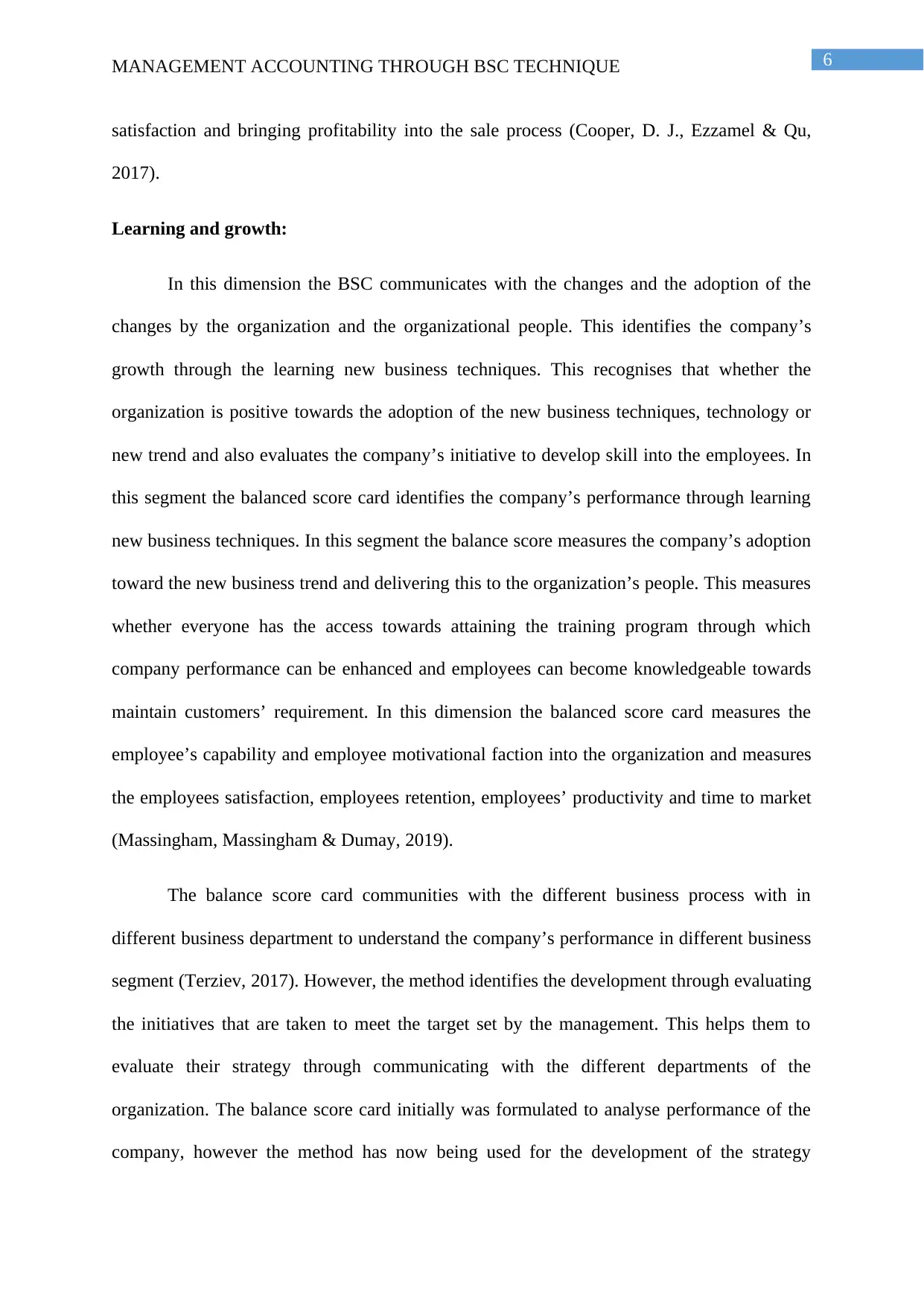
6MANAGEMENT ACCOUNTING THROUGH BSC TECHNIQUE
satisfaction and bringing profitability into the sale process (Cooper, D. J., Ezzamel & Qu,
2017).
Learning and growth:
In this dimension the BSC communicates with the changes and the adoption of the
changes by the organization and the organizational people. This identifies the company’s
growth through the learning new business techniques. This recognises that whether the
organization is positive towards the adoption of the new business techniques, technology or
new trend and also evaluates the company’s initiative to develop skill into the employees. In
this segment the balanced score card identifies the company’s performance through learning
new business techniques. In this segment the balance score measures the company’s adoption
toward the new business trend and delivering this to the organization’s people. This measures
whether everyone has the access towards attaining the training program through which
company performance can be enhanced and employees can become knowledgeable towards
maintain customers’ requirement. In this dimension the balanced score card measures the
employee’s capability and employee motivational faction into the organization and measures
the employees satisfaction, employees retention, employees’ productivity and time to market
(Massingham, Massingham & Dumay, 2019).
The balance score card communities with the different business process with in
different business department to understand the company’s performance in different business
segment (Terziev, 2017). However, the method identifies the development through evaluating
the initiatives that are taken to meet the target set by the management. This helps them to
evaluate their strategy through communicating with the different departments of the
organization. The balance score card initially was formulated to analyse performance of the
company, however the method has now being used for the development of the strategy
satisfaction and bringing profitability into the sale process (Cooper, D. J., Ezzamel & Qu,
2017).
Learning and growth:
In this dimension the BSC communicates with the changes and the adoption of the
changes by the organization and the organizational people. This identifies the company’s
growth through the learning new business techniques. This recognises that whether the
organization is positive towards the adoption of the new business techniques, technology or
new trend and also evaluates the company’s initiative to develop skill into the employees. In
this segment the balanced score card identifies the company’s performance through learning
new business techniques. In this segment the balance score measures the company’s adoption
toward the new business trend and delivering this to the organization’s people. This measures
whether everyone has the access towards attaining the training program through which
company performance can be enhanced and employees can become knowledgeable towards
maintain customers’ requirement. In this dimension the balanced score card measures the
employee’s capability and employee motivational faction into the organization and measures
the employees satisfaction, employees retention, employees’ productivity and time to market
(Massingham, Massingham & Dumay, 2019).
The balance score card communities with the different business process with in
different business department to understand the company’s performance in different business
segment (Terziev, 2017). However, the method identifies the development through evaluating
the initiatives that are taken to meet the target set by the management. This helps them to
evaluate their strategy through communicating with the different departments of the
organization. The balance score card initially was formulated to analyse performance of the
company, however the method has now being used for the development of the strategy
Paraphrase This Document
Need a fresh take? Get an instant paraphrase of this document with our AI Paraphraser
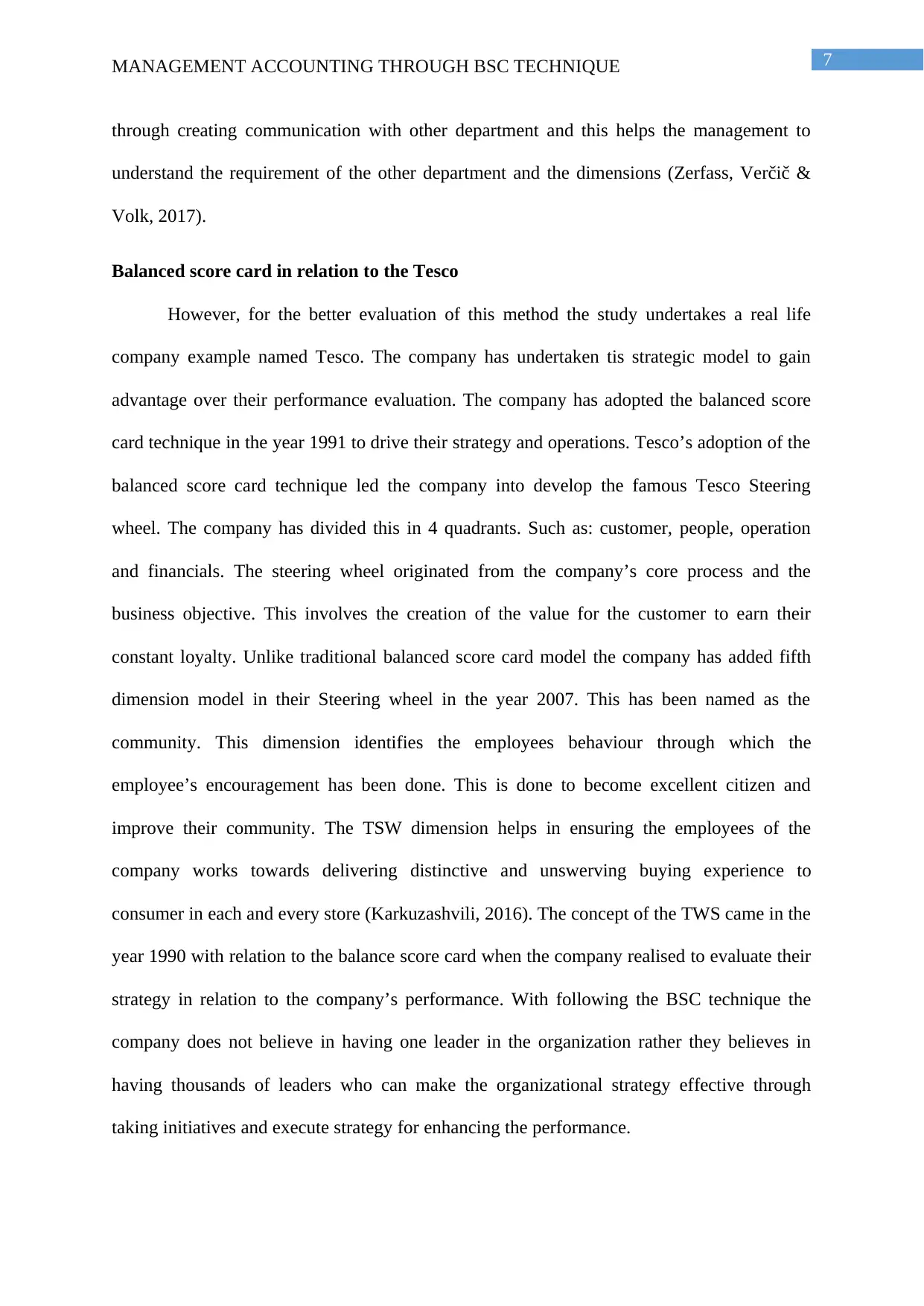
7MANAGEMENT ACCOUNTING THROUGH BSC TECHNIQUE
through creating communication with other department and this helps the management to
understand the requirement of the other department and the dimensions (Zerfass, Verčič &
Volk, 2017).
Balanced score card in relation to the Tesco
However, for the better evaluation of this method the study undertakes a real life
company example named Tesco. The company has undertaken tis strategic model to gain
advantage over their performance evaluation. The company has adopted the balanced score
card technique in the year 1991 to drive their strategy and operations. Tesco’s adoption of the
balanced score card technique led the company into develop the famous Tesco Steering
wheel. The company has divided this in 4 quadrants. Such as: customer, people, operation
and financials. The steering wheel originated from the company’s core process and the
business objective. This involves the creation of the value for the customer to earn their
constant loyalty. Unlike traditional balanced score card model the company has added fifth
dimension model in their Steering wheel in the year 2007. This has been named as the
community. This dimension identifies the employees behaviour through which the
employee’s encouragement has been done. This is done to become excellent citizen and
improve their community. The TSW dimension helps in ensuring the employees of the
company works towards delivering distinctive and unswerving buying experience to
consumer in each and every store (Karkuzashvili, 2016). The concept of the TWS came in the
year 1990 with relation to the balance score card when the company realised to evaluate their
strategy in relation to the company’s performance. With following the BSC technique the
company does not believe in having one leader in the organization rather they believes in
having thousands of leaders who can make the organizational strategy effective through
taking initiatives and execute strategy for enhancing the performance.
through creating communication with other department and this helps the management to
understand the requirement of the other department and the dimensions (Zerfass, Verčič &
Volk, 2017).
Balanced score card in relation to the Tesco
However, for the better evaluation of this method the study undertakes a real life
company example named Tesco. The company has undertaken tis strategic model to gain
advantage over their performance evaluation. The company has adopted the balanced score
card technique in the year 1991 to drive their strategy and operations. Tesco’s adoption of the
balanced score card technique led the company into develop the famous Tesco Steering
wheel. The company has divided this in 4 quadrants. Such as: customer, people, operation
and financials. The steering wheel originated from the company’s core process and the
business objective. This involves the creation of the value for the customer to earn their
constant loyalty. Unlike traditional balanced score card model the company has added fifth
dimension model in their Steering wheel in the year 2007. This has been named as the
community. This dimension identifies the employees behaviour through which the
employee’s encouragement has been done. This is done to become excellent citizen and
improve their community. The TSW dimension helps in ensuring the employees of the
company works towards delivering distinctive and unswerving buying experience to
consumer in each and every store (Karkuzashvili, 2016). The concept of the TWS came in the
year 1990 with relation to the balance score card when the company realised to evaluate their
strategy in relation to the company’s performance. With following the BSC technique the
company does not believe in having one leader in the organization rather they believes in
having thousands of leaders who can make the organizational strategy effective through
taking initiatives and execute strategy for enhancing the performance.
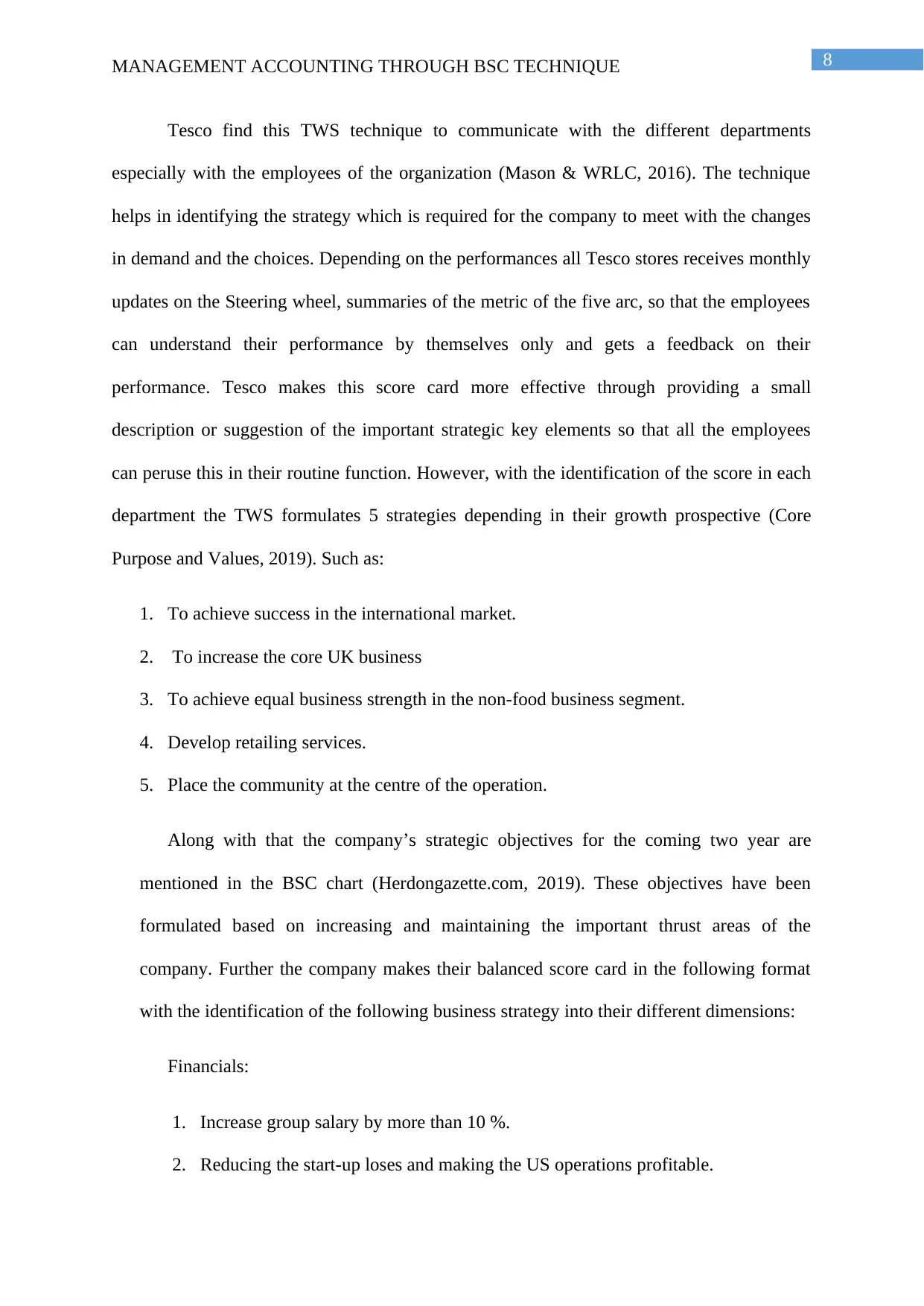
8MANAGEMENT ACCOUNTING THROUGH BSC TECHNIQUE
Tesco find this TWS technique to communicate with the different departments
especially with the employees of the organization (Mason & WRLC, 2016). The technique
helps in identifying the strategy which is required for the company to meet with the changes
in demand and the choices. Depending on the performances all Tesco stores receives monthly
updates on the Steering wheel, summaries of the metric of the five arc, so that the employees
can understand their performance by themselves only and gets a feedback on their
performance. Tesco makes this score card more effective through providing a small
description or suggestion of the important strategic key elements so that all the employees
can peruse this in their routine function. However, with the identification of the score in each
department the TWS formulates 5 strategies depending in their growth prospective (Core
Purpose and Values, 2019). Such as:
1. To achieve success in the international market.
2. To increase the core UK business
3. To achieve equal business strength in the non-food business segment.
4. Develop retailing services.
5. Place the community at the centre of the operation.
Along with that the company’s strategic objectives for the coming two year are
mentioned in the BSC chart (Herdongazette.com, 2019). These objectives have been
formulated based on increasing and maintaining the important thrust areas of the
company. Further the company makes their balanced score card in the following format
with the identification of the following business strategy into their different dimensions:
Financials:
1. Increase group salary by more than 10 %.
2. Reducing the start-up loses and making the US operations profitable.
Tesco find this TWS technique to communicate with the different departments
especially with the employees of the organization (Mason & WRLC, 2016). The technique
helps in identifying the strategy which is required for the company to meet with the changes
in demand and the choices. Depending on the performances all Tesco stores receives monthly
updates on the Steering wheel, summaries of the metric of the five arc, so that the employees
can understand their performance by themselves only and gets a feedback on their
performance. Tesco makes this score card more effective through providing a small
description or suggestion of the important strategic key elements so that all the employees
can peruse this in their routine function. However, with the identification of the score in each
department the TWS formulates 5 strategies depending in their growth prospective (Core
Purpose and Values, 2019). Such as:
1. To achieve success in the international market.
2. To increase the core UK business
3. To achieve equal business strength in the non-food business segment.
4. Develop retailing services.
5. Place the community at the centre of the operation.
Along with that the company’s strategic objectives for the coming two year are
mentioned in the BSC chart (Herdongazette.com, 2019). These objectives have been
formulated based on increasing and maintaining the important thrust areas of the
company. Further the company makes their balanced score card in the following format
with the identification of the following business strategy into their different dimensions:
Financials:
1. Increase group salary by more than 10 %.
2. Reducing the start-up loses and making the US operations profitable.
⊘ This is a preview!⊘
Do you want full access?
Subscribe today to unlock all pages.

Trusted by 1+ million students worldwide
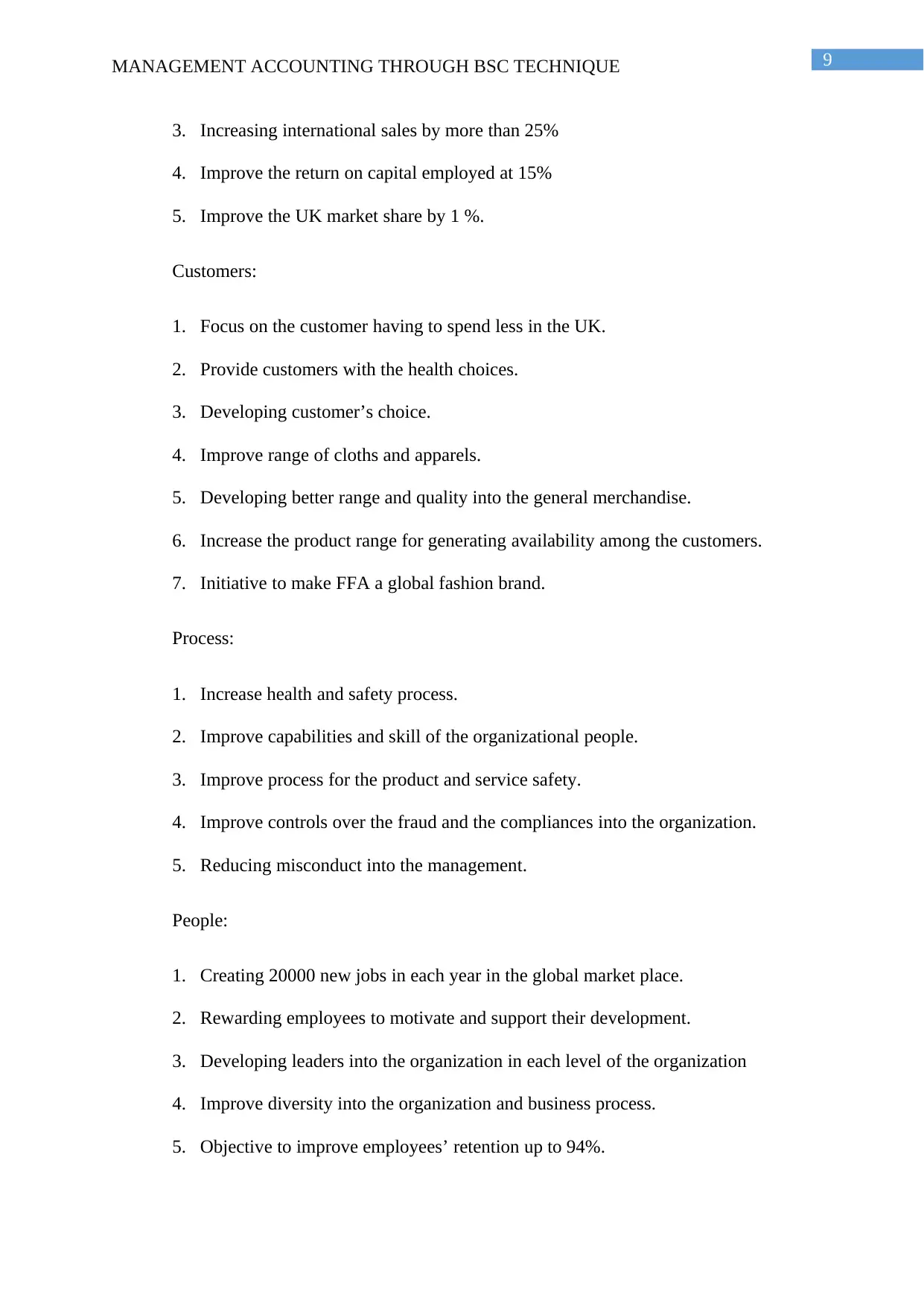
9MANAGEMENT ACCOUNTING THROUGH BSC TECHNIQUE
3. Increasing international sales by more than 25%
4. Improve the return on capital employed at 15%
5. Improve the UK market share by 1 %.
Customers:
1. Focus on the customer having to spend less in the UK.
2. Provide customers with the health choices.
3. Developing customer’s choice.
4. Improve range of cloths and apparels.
5. Developing better range and quality into the general merchandise.
6. Increase the product range for generating availability among the customers.
7. Initiative to make FFA a global fashion brand.
Process:
1. Increase health and safety process.
2. Improve capabilities and skill of the organizational people.
3. Improve process for the product and service safety.
4. Improve controls over the fraud and the compliances into the organization.
5. Reducing misconduct into the management.
People:
1. Creating 20000 new jobs in each year in the global market place.
2. Rewarding employees to motivate and support their development.
3. Developing leaders into the organization in each level of the organization
4. Improve diversity into the organization and business process.
5. Objective to improve employees’ retention up to 94%.
3. Increasing international sales by more than 25%
4. Improve the return on capital employed at 15%
5. Improve the UK market share by 1 %.
Customers:
1. Focus on the customer having to spend less in the UK.
2. Provide customers with the health choices.
3. Developing customer’s choice.
4. Improve range of cloths and apparels.
5. Developing better range and quality into the general merchandise.
6. Increase the product range for generating availability among the customers.
7. Initiative to make FFA a global fashion brand.
Process:
1. Increase health and safety process.
2. Improve capabilities and skill of the organizational people.
3. Improve process for the product and service safety.
4. Improve controls over the fraud and the compliances into the organization.
5. Reducing misconduct into the management.
People:
1. Creating 20000 new jobs in each year in the global market place.
2. Rewarding employees to motivate and support their development.
3. Developing leaders into the organization in each level of the organization
4. Improve diversity into the organization and business process.
5. Objective to improve employees’ retention up to 94%.
Paraphrase This Document
Need a fresh take? Get an instant paraphrase of this document with our AI Paraphraser
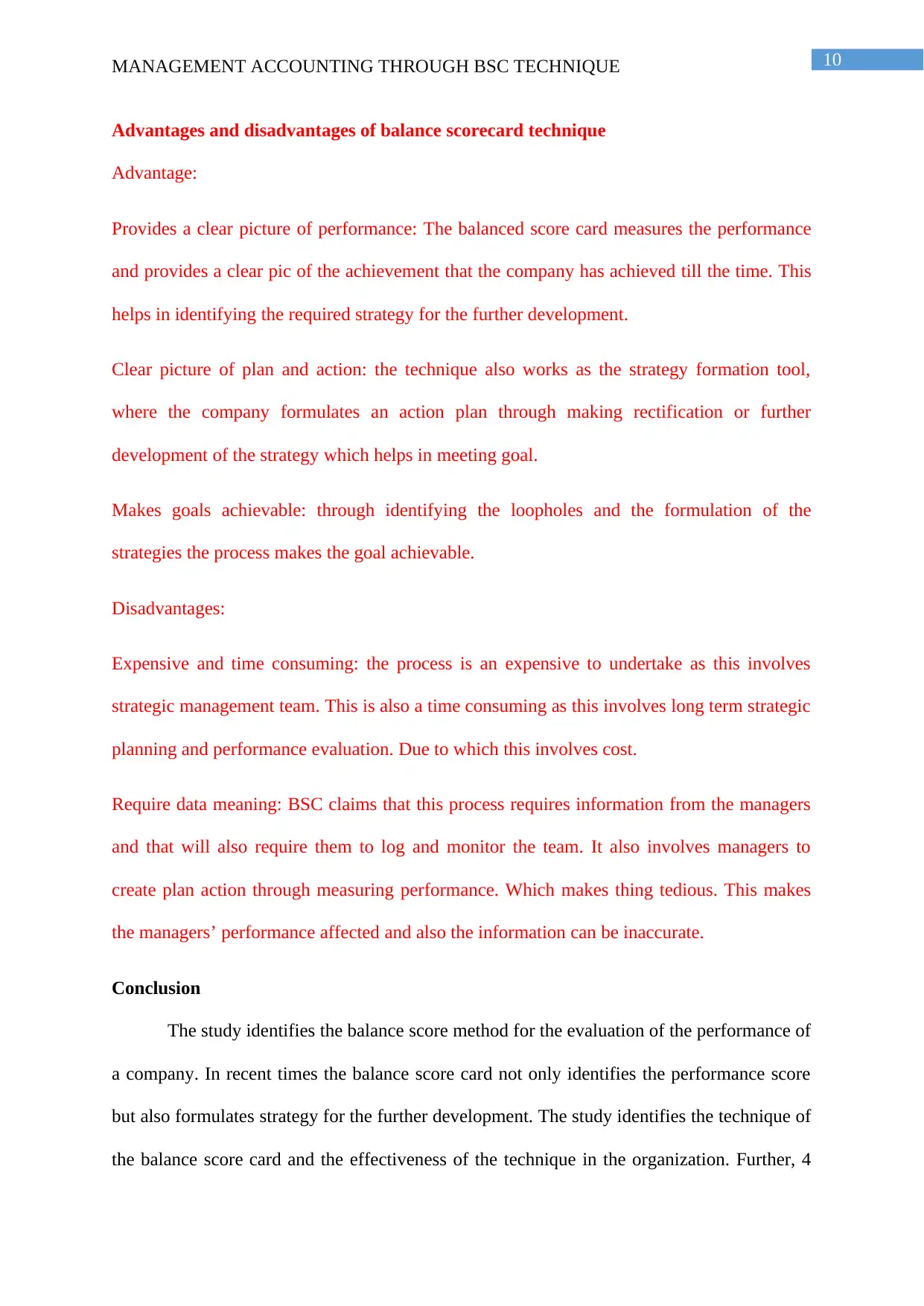
10MANAGEMENT ACCOUNTING THROUGH BSC TECHNIQUE
Advantages and disadvantages of balance scorecard technique
Advantage:
Provides a clear picture of performance: The balanced score card measures the performance
and provides a clear pic of the achievement that the company has achieved till the time. This
helps in identifying the required strategy for the further development.
Clear picture of plan and action: the technique also works as the strategy formation tool,
where the company formulates an action plan through making rectification or further
development of the strategy which helps in meeting goal.
Makes goals achievable: through identifying the loopholes and the formulation of the
strategies the process makes the goal achievable.
Disadvantages:
Expensive and time consuming: the process is an expensive to undertake as this involves
strategic management team. This is also a time consuming as this involves long term strategic
planning and performance evaluation. Due to which this involves cost.
Require data meaning: BSC claims that this process requires information from the managers
and that will also require them to log and monitor the team. It also involves managers to
create plan action through measuring performance. Which makes thing tedious. This makes
the managers’ performance affected and also the information can be inaccurate.
Conclusion
The study identifies the balance score method for the evaluation of the performance of
a company. In recent times the balance score card not only identifies the performance score
but also formulates strategy for the further development. The study identifies the technique of
the balance score card and the effectiveness of the technique in the organization. Further, 4
Advantages and disadvantages of balance scorecard technique
Advantage:
Provides a clear picture of performance: The balanced score card measures the performance
and provides a clear pic of the achievement that the company has achieved till the time. This
helps in identifying the required strategy for the further development.
Clear picture of plan and action: the technique also works as the strategy formation tool,
where the company formulates an action plan through making rectification or further
development of the strategy which helps in meeting goal.
Makes goals achievable: through identifying the loopholes and the formulation of the
strategies the process makes the goal achievable.
Disadvantages:
Expensive and time consuming: the process is an expensive to undertake as this involves
strategic management team. This is also a time consuming as this involves long term strategic
planning and performance evaluation. Due to which this involves cost.
Require data meaning: BSC claims that this process requires information from the managers
and that will also require them to log and monitor the team. It also involves managers to
create plan action through measuring performance. Which makes thing tedious. This makes
the managers’ performance affected and also the information can be inaccurate.
Conclusion
The study identifies the balance score method for the evaluation of the performance of
a company. In recent times the balance score card not only identifies the performance score
but also formulates strategy for the further development. The study identifies the technique of
the balance score card and the effectiveness of the technique in the organization. Further, 4
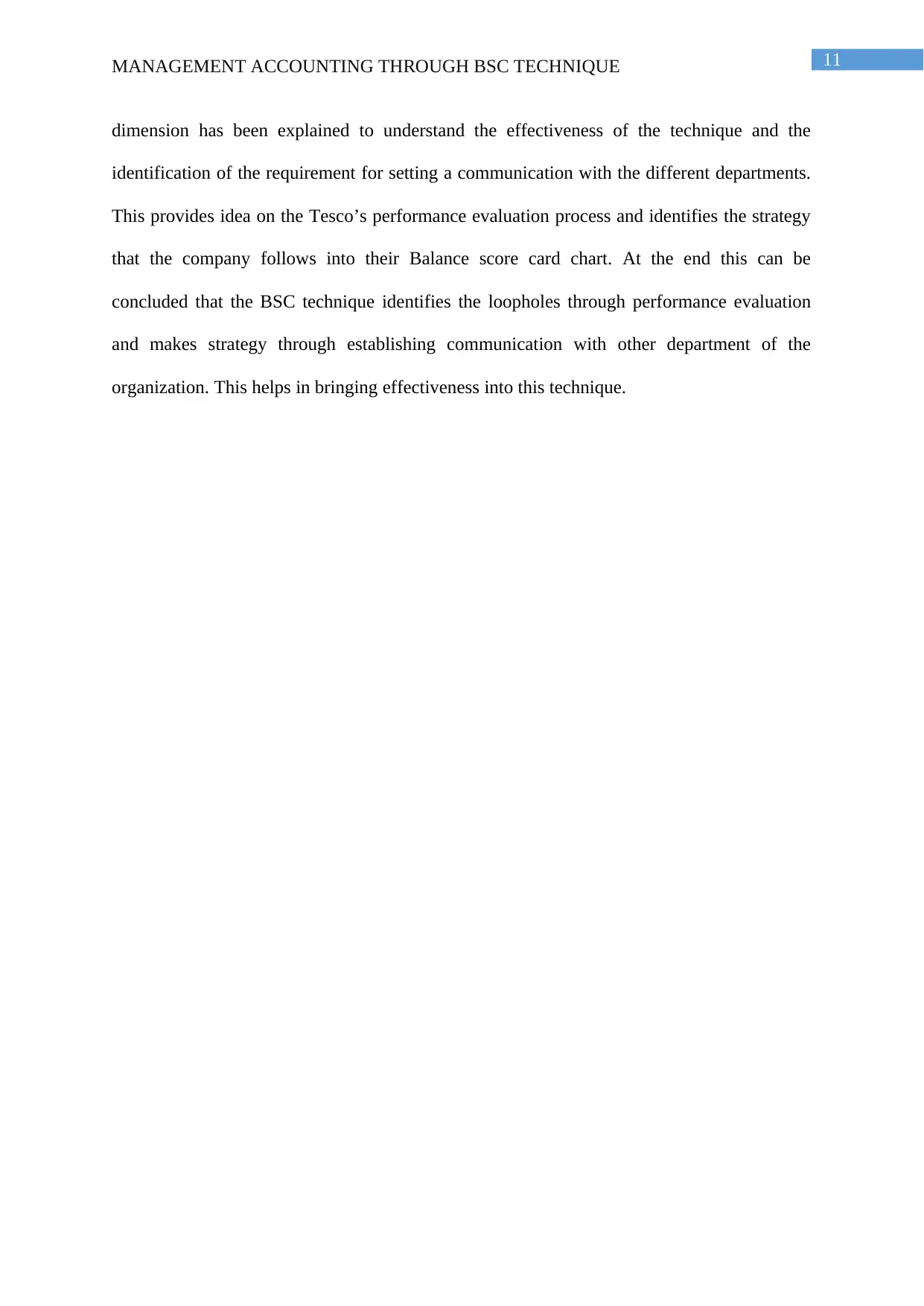
11MANAGEMENT ACCOUNTING THROUGH BSC TECHNIQUE
dimension has been explained to understand the effectiveness of the technique and the
identification of the requirement for setting a communication with the different departments.
This provides idea on the Tesco’s performance evaluation process and identifies the strategy
that the company follows into their Balance score card chart. At the end this can be
concluded that the BSC technique identifies the loopholes through performance evaluation
and makes strategy through establishing communication with other department of the
organization. This helps in bringing effectiveness into this technique.
dimension has been explained to understand the effectiveness of the technique and the
identification of the requirement for setting a communication with the different departments.
This provides idea on the Tesco’s performance evaluation process and identifies the strategy
that the company follows into their Balance score card chart. At the end this can be
concluded that the BSC technique identifies the loopholes through performance evaluation
and makes strategy through establishing communication with other department of the
organization. This helps in bringing effectiveness into this technique.
⊘ This is a preview!⊘
Do you want full access?
Subscribe today to unlock all pages.

Trusted by 1+ million students worldwide
1 out of 14
Related Documents
Your All-in-One AI-Powered Toolkit for Academic Success.
+13062052269
info@desklib.com
Available 24*7 on WhatsApp / Email
![[object Object]](/_next/static/media/star-bottom.7253800d.svg)
Unlock your academic potential
Copyright © 2020–2025 A2Z Services. All Rights Reserved. Developed and managed by ZUCOL.




